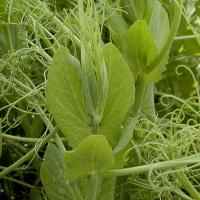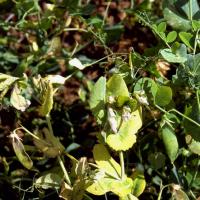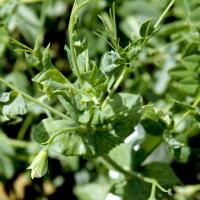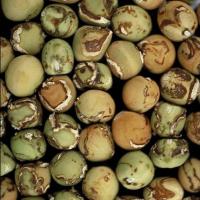Pea seed-borne mosaic virus (PSbMV) is non-persistently aphid-borne and reaches high seed transmission rates. Symptoms are:
- Usually mild, and plants may be infected without showing symptoms.
- Margins of young leaves roll downwards, there is mild chlorosis and mosaics, mild vein clearing may develop.
- Terminal leaves are often reduced in size and tendrils excessively curled.
- Infection at later growth stages may result in top leaves turning pale.
- Infected plants may also produce distorted flowers, which give rise to small distorted pods and fewer seeds. The seed coats may split as the seeds mature, and dark brown rings and tan spots develop.
Alfalfa mosaic virus (AMV) is non-persistently aphid-borne, and develops low rates of seed transmission in peas
- Chlorosis and necrosis of new shoots. Necrotic spots or streaking of older leaves.
- Pods may be malformed and fail to develop seed.
Bean yellow mosaic virus (BYMV) is non-persistently aphid borne, and develops a low rate of seed transmission
- Variable symptoms, but plants sometimes become infected symptomlessly.
- When foliage symptoms develop, these consist of vein clearing and mottles and mosaics especially on young leaves.
- Necrosis sometimes develops in stems and veins.
Cucumber mosaic virus (CMV is non-persistently aphid borne and develops a low rate ofseed transmission.Foliage symptoms are mild and difficult to observe. Possible leaf chlorosis and slight stunting.
Beet western yellows virus (BWYV) persistently aphid-borne; no seed transmission.BWYV causes symptomless infection in peas in WA
PSbMV is the most important viral disease in pea in Western Australia because most seed stocks are infected and it both reduces seed yields and damages seed quality. BYMV is the second most important virus as it causes severe symptoms in pea despite occurring at lower levels than PSbMV. BWYV is the most widespread virus but is of less economic importance because its infection is symptomless in pea in WA. Some viruses causing severe symptoms in peas in the eastern states are not found in peas in WA.











